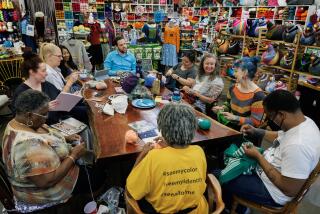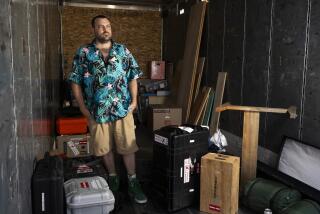Cottage Industries Spring Up : In-Home Businesses Are Booming
SAN FRANCISCO — Carol DuChamp Katz runs a high-energy specialized tour business from a low-key office about 20 yards from the front door of her rural, Northern California home.
If she needs to contact her husband, James, she can usually just wave. He’s probably detailing plans for a river-running adventure from his office in an adjoining building 10 feet away.
The Katzes are among about 18 million American workers who don’t have to fight commuter traffic, ride crowded elevators or wait in lines for their lunch. Using their computers and telephones, the couple operate thriving at-home businesses that pay the bills while giving them the opportunity to trek to exotic locales around the world.
“In an old-fashioned sense, we’re running a cottage industry similar to the way things were 200 years ago, when there wasn’t so much separation between work and the home,” said Carol, who combined her knowledge as a former travel agent with her love of painting to create “Art Trek,” a series of summer workshop expeditions for artists.
She said each trip consists of about 16 participants, ranging from beginning artists to professionals, and includes an art instructor and a guide, often herself. The trips combine painting with exploring and are offered to the American Southwest, southern France and Tahiti. A new trek to Bali is scheduled next year.
“It’s one thing to travel, but it’s another to travel as a painter,” she said.
Her husband, founder and director of James Henry River Journeys and Wilderness Journeys, provides similar services for outdoor enthusiasts and engages top naturalists in emphasizing the theme of adventure, learning and camaraderie.
Time Together
“We’re the tour operators, doing all our own reservations, processing and detail work,” Carol said. “It’s worked really well and is a nice life style for us. It enables us to go out and travel and adventure together.”
In fact, the Katzes were busily packing equipment for a 10-day river trip in Alaska with their 7-year-old daughter, Danielle, who did her first white-water rafting at four months.
Other at-home businesses have been started by entrepreneurs on both large and small scales and include such services as catering, gardening, landscaping, giving exercise or music lessons and running a mobile auto repair service. One woman even started a “butler” service for pets--walking, feeding and pampering them for busy or vacationing owners--and says she’s booked with clients for the next year.
The Bureau of Labor Statistics estimated in a recent survey that 18 million Americans have a home business or use their home for business regularly for at least eight hours a day.
A trend toward “telecommuting” has accelerated in many large firms where employees can use a computer connected to the main office via a modem to do various white-collar chores without leaving home. The explosion in computer access to information allows such people to research topics, find the latest stock quotes, or get up-to-date news and weather reports.
When investment consultant Kenneth Fisher decided to launch Fisher Investments, the marketing whiz didn’t open a suite in a city skyscraper; he started a “financial factory” 2,200 feet up in the San Mateo mountains where he lived.
The reason, he said, wasn’t to cut commuting, avoid crowds or save money. It was a life style issue so he could be close to his wife and three sons.
“I needed to work very long hours without having it detract from my family life,” Fisher said. “I’ve created a modern, 20th century cottage industry environment that is patterned on ideals that existed during the American Revolution.”
Small Staff
Fisher has a small staff, a computer room and satellite antennae to gather and process financial information needed in an investment service that manages a $175-million portfolio for 120 wealthy clients.
Fisher said setting up business on his 3-acre property in Woodside helped mend a rocky relationship with his wife, who is now actively involved in the firm.
“We don’t have to look at each other and say, ‘What did you do today?’ We’ve eliminated those empty, hollow, feelings,” Fisher said. “Also, I can be working on a Saturday and look out the window and see my boys on their skateboards, and they see me. That’s important to me.”
Even though he’s in an out-of-the-way location, Fisher said his business has grown rapidly since he established it there in 1985.
“Because of the woods, the beautiful setting, clients love to come here,” Fisher said. “The other side of the coin is they generally can’t find us.”
Moonlighting in Toys
On a smaller scale, in the Southern California town of Glendale, Marian Bennington is “moonlighting” with a garage full of wood blocks. The product, called “Funwood” is a 65-piece set of small hemlock blocks, hand sanded, with rounded corners for safety. The set comes unpainted with 11 shapes in an oversized pine box for $17.50.
“Right now it’s a sideline; I go to lots of arts and crafts fairs,” said Bennington, whose brother, Doug Shutes, recently started the business from his garage in Seattle, where he makes the blocks.
“The product sells itself once people see it,” said Bennington, who works in an insurance office while pursuing the business she hopes will someday become her full-time occupation through mail-order and direct selling. “It’s a good wholesome toy for kids. All they need is their imagination.”
The arts and crafts field is a fertile area for people who want to work part time or even full-time from home. Turning a hobby into an occupation isn’t easy, however.
About 52 million people technically consider themselves craftsmen, and 72 million work with crafts, said Ken Heller, who offers a Craftworker’s Marketing Directory through his company, Breakthrough Communications of Wheaton, Md.
For many people, working at home is an ideal way of conserving time, energy and money, especially when doing something enjoyable. For others, particularly about 600,000 women with children younger than 6, attempting a home-based job as a solution for combining work with a family has been a double-edged sword.
Problems for Women
Kathleen Christensen, a New York environmental psychologist who did a major national survey on the subject, said many women who try to work from home face loneliness, isolation and credibility problems. As a child-care alternative, it doesn’t always work, Christensen said, since 50% of those surveyed had to have outside day care in order to take care of business.
Also, women at home face household demands and interruptions by neighbors, delivery people or others, said Christensen, who outlines her findings in the book, “Women and Home-Based Work.” (Holt & Co., $17.95).
“To work effectively at home a work environment must be established and protected by distinct boundaries,” Christensen said. “Only certain hours can be worked; limits are put on housework or child care while you work; work is confined to one room and treated exactly as it would be in an office. Rules are necessary and must be made and kept.”
More to Read
Sign up for The Wild
We’ll help you find the best places to hike, bike and run, as well as the perfect silent spots for meditation and yoga.
You may occasionally receive promotional content from the Los Angeles Times.






